The cultivation of flowers is also called floriculture, a branch of horticulture that deals with flowering plants. Floriculture crops include houseplants, bedding plants, cut greens, and cut flowers.
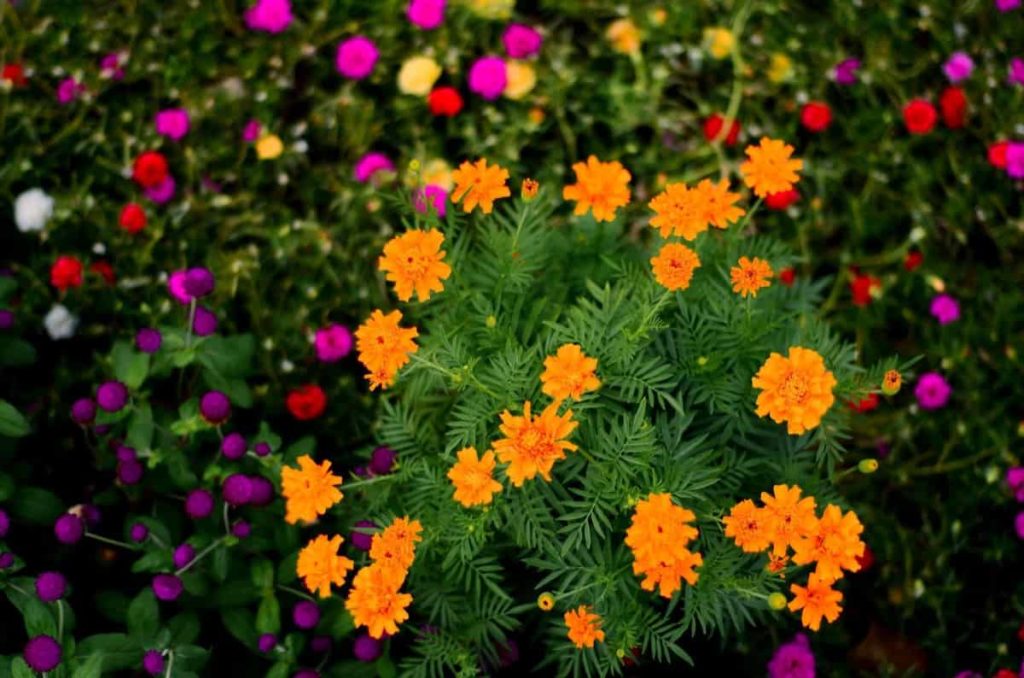
Flower gardening/farming ideas
Why is flower farming important?
Floriculture is one of the most promising components of the horticulture industry, important from aesthetic, social, and economic points of view. Cut flower farming business is known as a profitable business in India. It has grown from a backyard garden to a global industry in all countries where it is practiced. Interest in growing flowers has drawn many people to the business of floriculture.
Starting a flower garden is great for the environment for several reasons. The first reason is that flowers undergo photosynthesis to produce chlorophyll. During photosynthesis, flowering plants absorb carbon dioxide from the air and release oxygen. It helps reduce CO2 emissions and provides cleaner, oxygen-rich air.
What are the benefits of indoor flower farming?
- It saves space and uses the space in a better way.
- Plants are not affected by the weather.
- Indoor vertical farming helps improve biodiversity by not disturbing the land surface.
- Environmentally friendly, as it removes pollutants from the environment.
- It improves mood and reduces stress and stress-related depression.
What tools do I need to water flower plants?
- Water Hose – It is essential for getting water from the tap to your garden.
- Nozzle – It allows you to deliver water to the base of individual plants.
- Watering Wand – The watering wand provides a gentle spray without bending or tilting.
- Soaker Hose – The soaker hose allows you to water your soil directly and deliver moisture efficiently. Place the hose under the mulch to maintain a beautiful garden.
- Sprinklers – Flower bed sprinklers rain light moisture onto your plants. Ideal for new flower beds and less crowded areas, an elevated sprinkler is attractive without distracting your flowers.
In case you missed it: How to Control Aphids on Plants Naturally and Organically: In Vegetables, Fruits, Herbs, and Flowers
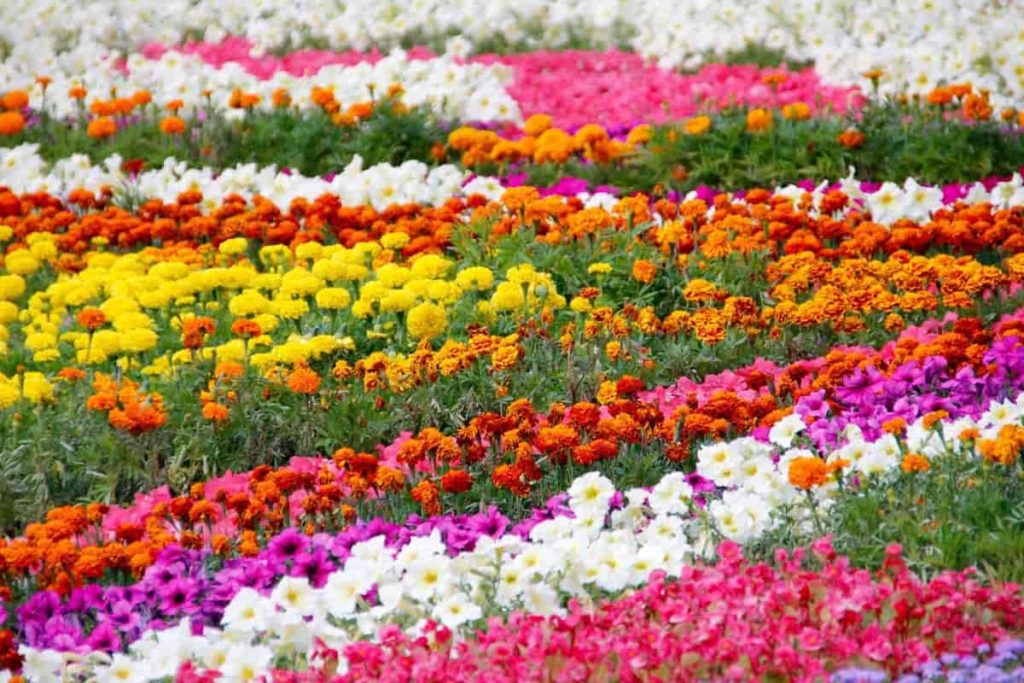
Can I grow flowers in my greenhouse?
Growers cultivate a wide range of potted flowering plants, cut flowers, and annual bedding plants. The floriculture sector requires a lot of technology and capital and is highly competitive. By providing a controlled environment, greenhouses also make an ideal place for ornamental flowers. But before you embark on your greenhouse flower-growing adventure, keep in mind the special needs of these plants. These include sunlight, temperature, water, and more. It allows a gardener to control the climate, regardless of what is happening outside.
With better control, you can grow various flowers in a greenhouse. This climate control in a greenhouse can be done with unheated greenhouses or cold frames but is the least flexible of greenhouse structures. A year-round greenhouse requires some complex systems with heating and cooling systems, ventilation, lights, and shades to cover plants that need darkness to flower. Geranium, Impatience, Petunias, Salvia, Caladiums, Poinsettias, and Chrysanthemums are plants to grow in a greenhouse.
How do you grow beautiful flowers?
- Choose a sunny location
- Make your flower garden accessible
- Mix your soil for good drainage
- Design your flower garden before planting
- Give the flowers plenty of room to grow
- Choose flowers with different bloom seasons
- Choose flowers that are easy to grow
Use rich soil – Soil rich in loose and organic matter such as old manure or well-rotted compost provides a constant supply of nutrients to plants. It also encourages bacterial activity, which promotes soil fertility. When planting your flower bed, add some manure or compost to the soil and add it from time to time.
Deadhead more – Most plants grow better and have more flowers if their wilted and wilted flowers are plucked more often. Withered flowers waste energy and sap. They also attract pests and diseases. Also, by cutting off faded flowers, you prevent plants from seeding.
Fertilize the plants – Feed plants regularly during the growing season with a half-strength liquid fertilizer for more blooms. Use a flowering fertilizer that contains more phosphorus than nitrogen, as phosphorus is the element that promotes more flower buds. Also, you can add a timed fertilizer to the soil at the beginning of the growing season.
Apply mulch – Plants grown in mulched soil are generally stronger and less prone to pests and diseases.
In case you missed it: Indian Gardening in the USA: For Home, Containers, Backyard, Vegetables, Flowers, Herbs, and Fruits
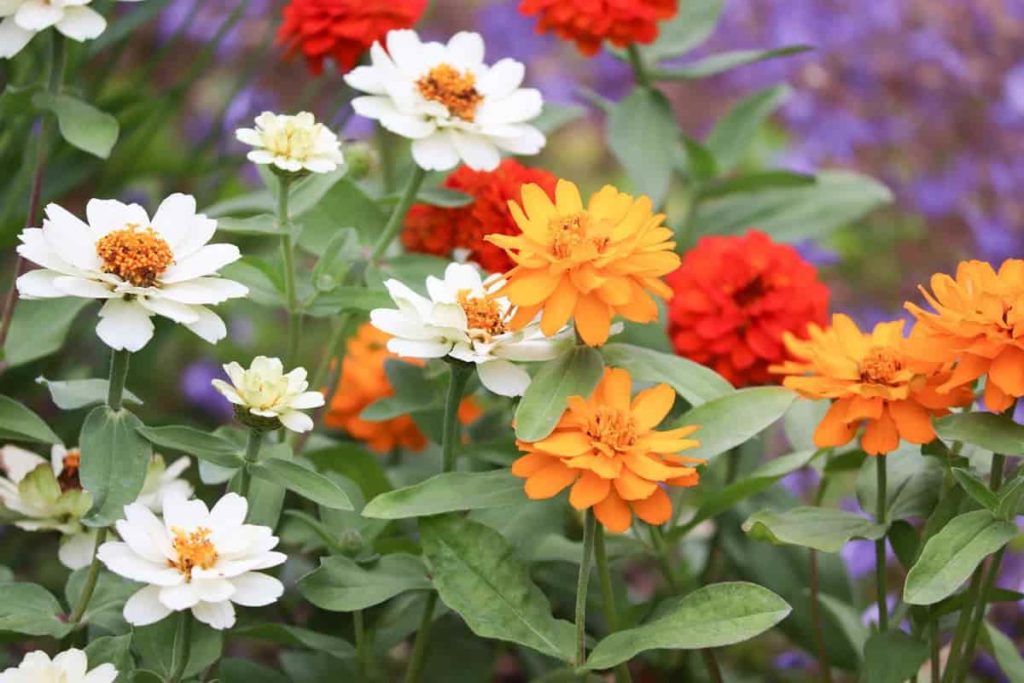
What are the types of flower cultivation?
- Cut flowers – These flowers are cut with roots, branches, and leaves for use in bouquets or decorations.
- Dried flowers – These flowers are used after drying. These flowers are dried using different preservatives and used for different occasions.
- Pot plants – These flowers are grown in pots suitable for indoor farming and home gardening.
- Bedding plants – In these plants, seeds are sown indoors in the off-season, and plants are transplanted later in the growing season.
- Hanging plants– These are annual or perennial flowering or other herbaceous plants used for decorative purposes. These are suspended from the ceiling by ropes.
How to start a balcony flower garden?
Before choosing containers for your balcony garden, determine whether you need a permit to start your garden, learn about balcony gardens, and, if the plan is ambitious, take safety precautions. High-quality poly-resin garden containers are indistinguishable from glazed pottery or stoneware and weigh only a fraction of the real thing. South- or west-facing balcony will get full sun, which is perfect for almost all flowering plants. If you have an east-facing balcony, it will have partial daylight due to morning sun exposure.
In this case, you can grow flowers that prefer partial suns, such as Begonias and Bleeding Hearts. For a north-facing balcony, plant flowers that tolerate full shade, such as Impatiens, Snowdrops, Lilies Of The Valley, Hydrangeas, and Hostas. Watering is usually the first challenge for balcony gardeners. The prospect of an unexpected muddy shower won’t thrill your neighbor below you. You’ll need a gravity-fed irrigation system with at least a five-gallon reservoir.
Other balconies watering ideas include using capillary mats or drip caps attached to recycled two-liter plastic bottles. Buy containers and railing planters of different sizes and use plant stands to add vertical interest to your balcony flower garden. When choosing containers, prefer not to have them in every other color you can find.
What soil is best for planting flowers?
Soils come in three main types – sand, clay, and silt. Generally, the best potting soil for growing flowers is an equal mixture of the three soil types mentioned above and is called sandy loam. This mixture will ensure the best growing conditions for most flowers.
To start a flower garden, topsoil should be nutrient-rich, fertile, and have the right balance of silt, sand, and minerals. Remember that good soil is not too sticky and allows for good drainage. Also, the plant roots must be deep in the soil so the plant is stable and grows well.
What are the easiest flowers to grow for beginners?
Easy flowers to grow for beginners are Sunflowers, Cosmos, Marigold, Zinnia, Petunia, Calendula, Portulaca, and Nasturtium.
What to feed plants to encourage flowering?
- Nitrogen promotes healthy leaf and shoots growth, phosphorus helps root growth, and potassium encourages flower production.
- A typical fertilizer offers a balance of all three major nutrients, plus many minor trace elements –from magnesium and iron to manganese and molybdenum.
A complete fertilizer is essential to provide flower plants with the three key elements they need to thrive:
- Nitrogen (N): Promotes lush plant growth.
- Phosphorus or Phosphate (P): Promotes flowering and fruit formation.
- Potassium or Potash (K): Promotes a healthy root system.
Why are my plants not flowering?
The lack of blooms is as varied as the palette of plants to choose from, but a little detective work can pinpoint the problem. The common factors associated with blooming, or lack thereof, include light, nutrition, plant age, extreme temperatures, and improper pruning.
Using too much fertilizer – Feeding your plants more nitrogen fertilizer will promote lots of green, leafy growth, but all that growth usually comes at the expense of flowers. It is also true that plants need phosphorus to set flower buds. But before fertilizing, you need to look at the whole picture.
How do you start flower gardening for beginners?
- Your flower garden can be started as small as a window box or patio container.
- Prioritize and plan your flower garden according to height, color, and spacing.
- Mulching flower beds helps control moisture loss from the soil.
- Make sure tall plants don’t block the sunlight needed by smaller plants.
- When you buy a flowering plant from a nursery, don’t immediately transfer it to a new pot or soil. Let the flowering plant settle in the new environment for at least a week—transplant in the evening and not in strong sunlight.
- A fertilizer rich in phosphorus helps in flower growth. Any manure or fertilizer should be applied once a month.
- Remove dried or dead flowers and add them back to the soil.
- Avoid overwatering the plants, as this can kill the plant.
What fertilizer helps flowers bloom?
To speed up blooming, choose fertilizers with a high percentage of phosphorus compared to the percentage of potassium and nitrogen. Healthy flowers growing with a strong root system and a potassium boost ensures your flowers get off to a good start. Fertilize the plant once in the spring when new growth starts or during bed preparation. There are several ways to provide nutrients to flowering plants. These mainly include granular chemical fertilizers, which may or may not be controlled release, water-soluble fertilizers, and organic fertilizers.
In case you missed it: How to Grow Flowers at Home: From Seeds, Without Seeds, for Indoors/Outdoors, and Containers
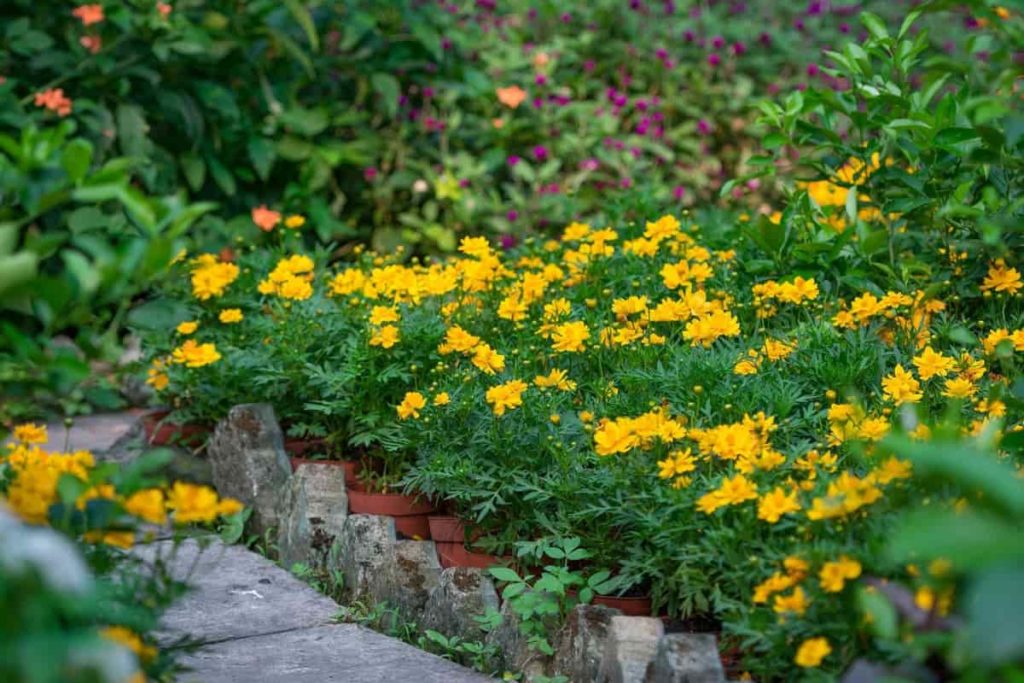
Flower plants use a lot of energy to bloom and produce beautiful flowers. Some are heavier feeders than others. Many varieties of annuals and perennials will grow and bloom just fine without any fertilizer, but others require an extra boost once in a while. It is essential for plants in containers. Once nutrients are depleted in potting soil, they cannot be replenished by nature as they are in the soil.
What is a natural fertilizer for flowers?
Natural fertilizers rely on the plant, mineral, and animal sources for their nutrients. Common ingredients in natural fertilizers include bone meal, blood meal, fish meal, manure, greensand, rock phosphate, alfalfa meal, kelp, and compost. Organic fertilizers can be used to supply nutrients to flowering plants.
They can be purchased as complete fertilizers in liquid or solid bulk form. Organic fertilizers are lower in nutrient analysis and solubility than synthetic fertilizers. Therefore, they may need to be applied at higher rates, and more attention should be paid to soil preparation during the early stages of bed preparation to ensure uniform distribution. Add organic matter to the soil well.
When should I fertilize my flowers?
You can fertilize flower beds and pots anytime during the morning, day or evening; the part doesn’t matter. As for the time of year, you must start feeding the flowers in spring and stop at the end of summer. Do not fertilize flower plants when they are dormant in the fall or winter.
Can I grow flowers in hydroponics?
You can grow more flower plants in a smaller area with hydroponics than in traditional gardening. You also use less water with a hydroponic system than with traditional soil gardening. Also, because hydroponic systems are indoors, you can grow and produce flowers all year round. Many flower gardeners consider hydroponic farming a serious alternative to traditional soil-grown gardens. If you like quick results, you will enjoy hydroponic farming.
A hydroponic garden is a self-contained growing unit typically consisting of growing plants, water reservoirs, and growing media. And it’s up to you to add hydroponic nutrients. Hydroponics has some advantages over traditional soil culture. It gives you complete control over both nutrient supply and pH balance. And there is no weed, pest, or disease stress, and plants grow 50 percent faster than plants grown in soil.
Any flower can be grown hydroponically. The best and most common plants to grow hydroponically for their beautiful flowers are often perennials such as Petunias, Orchids, Carnations, Roses, Daylilies, Lavender, Chrysanthemums, Peace Lilies, Snapdragons, Dahlias, Carnations, and Orchids.
Can Roses grow hydroponically?
One of the common flowers grown hydroponically is the Rose. The results are excellent and are more commonly done using the cling film technique.
Can I grow tulips hydroponically?
The Tulip is a good flower bulb crop that can be adapted to the hydroponic culture.
How do you make organic flowers?
Organic gardening minimizes using artificial chemicals such as fertilizers and pesticides but also involves a more holistic approach to gardening. Organic flower gardening makes gardening more environmentally friendly. There are some key principles important for learning to grow organically: good sites, healthy soil, biodiversity, sustainable resources, and avoidance of chemicals.
Choose a location with eight hours of direct sunlight daily for your organic flowers. Good soil rich in nutrients and structure and full of life is essential, especially in organic flower gardening. Well-structured and fertile soil allows plants to absorb water and nutrients and encourage vigorous growth. Add home compost, compost, or leaf mold to organic flower garden soil.
This heavy material slowly releases nutrients, improves soil conditions, and stimulates essential microbes. Inspect plants regularly and be careful. This way, you can find problems quickly with pests and diseases. The main goal of organic gardening is to keep the growing area healthy and free from pests and diseases. A diverse and active growing system, good hygiene, and close observation help prevent problems. Layers like bark mulch, composted straw, or leaves can naturally control and control weeds and kill off anything that emerges.
Do all flowering plants need to be pruned?
The thought of pruning flowering plants can give even the most experienced home gardener pause. But pruning is important to your plant’s growth and is a great way to bring in more flowers next season. But not all plants should be cut in the same way or at the same time of year. Pruning flower plants is done to give the plant a proper shape and direction, create a strong framework, control unwanted plant growth, increase the number of flowering branches, and remove dead and decaying branches, so pruning is a regular garden practice.
There are a few reasons for pruning flowering plants: to control plant size and shape, to improve flowering, and remove dead or diseased parts. Fall pruning is usually limited to these examples. In any case, most flowering plants require relatively little pruning.
Do indoor flowers need sunlight?
Light is the most important factor for flower plant growth. All plants need light for photosynthesis, the process within a plant that converts light, oxygen, and water into carbohydrates (energy). Plants need this energy to grow, flower, and produce seeds. Many flowers need at least six hours of sun to set the bud. Plants need sunlight to photosynthesize. This way, they take the raw carbon dioxide and water materials and convert them into the sugars they need to feed themselves. If they don’t get enough sunlight, they become stressed.
How do you water flowering plants?
Always water around the flowering plant and distribute it throughout the area. Drip or sprinkler irrigation is a great way to water plants. You can use an automatic irrigation system with an embedded moisture sensor – on the bed, balcony, or lawn. Waterlogging will damage and damage the roots. This one is very simple. How and how often you water your plants could easily be why they aren’t blooming.
In case you missed it: Top 40 Ways to Increase Crop Yield/Production: For Vegetables, Fruits, Flowers, Herbs, Tips, Ideas, and Techniques
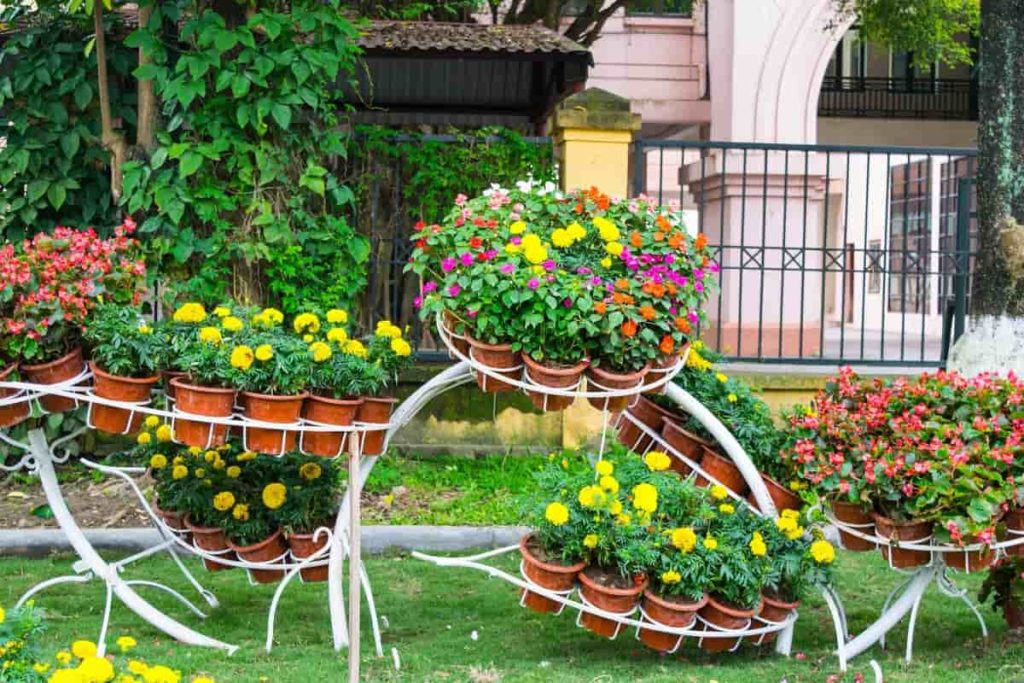
Some plants need more water than others, and overwatering can be just as big a problem as underwatering. Again, a little research into the details of your plants goes a long way. A good general rule of thumb for most flowers is an inch (2.5 cm) of water every seven to ten days. It is only for the growing season, though, as many flowers are less needed during the dormant part of the year.
How do I start a flower business?
- Understand the advantages and disadvantages of being a florist
- Develop floral design skills
- Create a business plan
- Select a location for your flower shop
- Create a website or online store
- Register your flower business
- Invest in market trends
- Market your business
Flowers are the most profitable crops, producing the highest profit of any specialty crop. You can start with little – just enough for seeds and supplies, and most new flower growers make money in the first year.
What flowers are best grown in pots?
- It is the easiest way to grow indoor flower farming. You’ll need some space, some containers with drainage holes and water.
- Flowers grown in pots are Geraniums, Petunias, Coral bells, Sedums, Hydrangeas, Begonias, and Coleus, Hibiscus, Orchids, African Violet, Begonias, Jasmine, Angelonia, Gerbera daisies, Impatiens, Marigolds, Dahlias, and Zinnias, etc.
Why are all my flowers dying?
One of the main reasons why flowers wilt is that they are not getting enough water. It can happen even if there is plenty of water in the vase, usually when there is no way for the water to enter the stem. The common factors associated with blooming, or lack thereof, include light, plant age, nutrition, extreme temperatures, and improper pruning.
Poor watering technique – Many people water at the wrong time of day. If your water is in the heat of the day, you’ll do two things: you’ll lose a lot of moisture through evaporation, and water droplets on plants can act as a magnifying glass for the sun, scorching the leaves. Water your flower plants in the morning or the last thing at night to conserve moisture and protect the delicate leaves.
Poor weeding – Don’t make us a hoe to cut the top of the weed. Many weeds have strong root structures beneath the soil. It would help if you dug up as much of the root as possible or used a systemic herbicide to absorb and kill the roots.
Too much nitrogen – Nitrogen promotes stem and leaf growth in plants. However, just as a plant can get too much water, it can also get too much nitrogen. So, if your plant looks green and healthy, but there are no flowers blooming – this could be the reason. To solve this problem, stop using your compost. Watering your plants will remove some of the excess nitrogen. Wait a few weeks, then switch to a new fertilizer with extra phosphorus and less nitrogen.
How can I get my plants to grow more flowers?
During summer, you must water your flowers at least once daily. Other seasons are quite cool and wet, and you can water your flowers twice a week. Garden soil loses fertility over time, giving plants insufficient nutrients. When you notice low soil fertility in your garden, you must immediately apply a proper fertilizer to your flowers.
Mulch well – Mulch helps the soil absorb water and maintain a constant moisture level. Apply about 3 inches of organic mulch evenly over your flower beds. Avoid applying mulch within 2 inches of the base of flowers and shrubs. Too much mulch against plants can promote disease and become home to harmful insects.
Prevent and control pests – Pests can easily kill flowering plants, so preventing them from invading your garden is important. You can keep out other pests by putting up barriers and traps. Some of the pests you should be aware of include mealybugs, caterpillars, aphids, whiteflies, and mealybugs. You can also remove severely infested plants to control the spread of pests. You can avoid fungal diseases by avoiding overwatering your garden, pots, or vases. On the other hand, you can avoid bacterial and viral diseases by using clean bushes and pruning tools.
In case you missed it: Top 50 Flower Farming Tips, Ideas, and Techniques
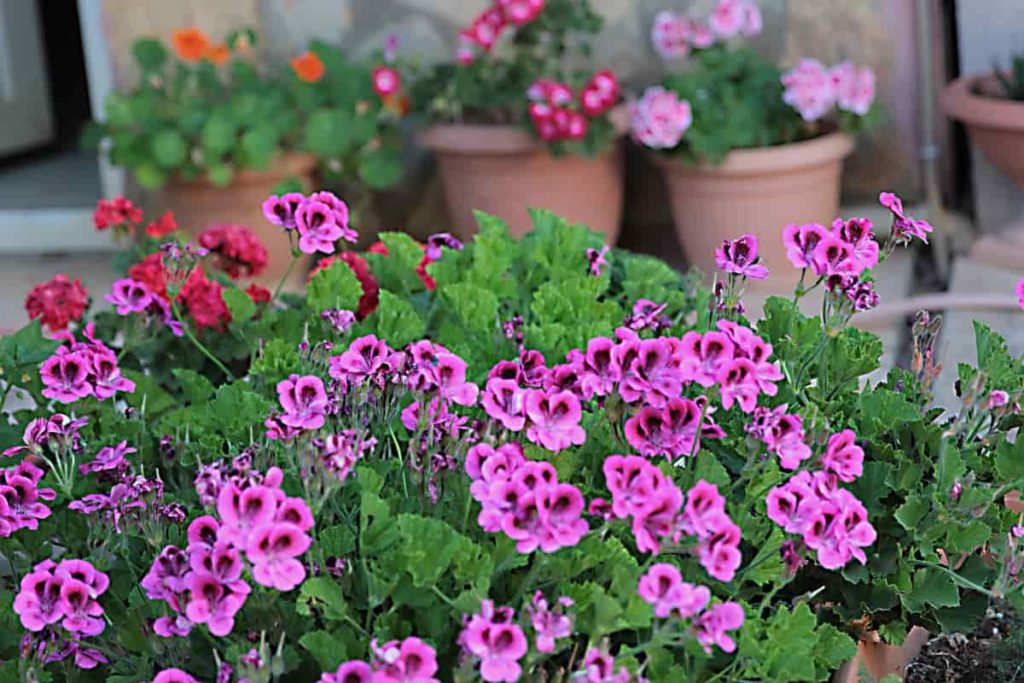
Pinch and prune your plants – Pinching is the process of removing stem tips to encourage lateral growth and promote good shape. It is recommended to pinch your plants to encourage branching and more flower formation. On the other hand, pruning is cutting off overgrown branches to control plant growth. If some plants grow wayward, you can prune them to achieve uniform heights and compact shapes.
Remove dying flowers – Everything has a season, and there will come a time when some of your flowers will begin to wilt and turn black. After several days, some individual flowers begin to wilt or die. To continue enjoying your blooms, remove dead or dying flowers as they reduce the beauty and start to rot and pollute healthy flowers. It will keep your arrangement looking fresh for longer.
Apply fertilizer timely – A good fertilizer provides nutrients and energy for plants to bloom, stay healthy, and grow each year. Although there are many choices of products out there, not all of them are right for fertilizing flowers.
Conclusion
Flowering plants always make your garden more exciting. For more tips on perfecting your flower garden, get started by reading this information.
- Types of Pesticides Used in Agriculture: A Beginner’s Guide
- Economical Aquaculture: A Guide to Low-Budget Fish Farming
- 15 Common Planting Errors That Can Doom Your Fruit Trees
- How to Make Houseplants Bushy: Effective Tips and Ideas
- Innovative Strategies for Boosting Coconut Pollination and Yield
- Pollination Strategies for Maximum Pumpkin Yield
- The Complete Guide to Chicken Fattening: Strategies for Maximum Growth
- Natural Solutions for Tulip Problems: 100% Effective Remedies for Leaf and Bulb-Related Issues
- Revolutionizing Citrus Preservation: Towards a Healthier, Greener Future
- Natural Solutions for Peony Leaf and Flower Problems: 100% Effective Remedies
- Maximizing Profits with Avocado Contract Farming in India: A Comprehensive Guide
- Natural Solutions for Hydrangea Problems: 100% Effective Remedies for Leaf and Flowers
- The Ultimate Guide to Choosing the Perfect Foliage Friend: Bringing Life Indoors
- From Sunlight to Sustainability: 15 Ways to Use Solar Technology in Agriculture
- The Ultimate Guide to Dong Tao Chicken: Exploring from History to Raising
- The Eco-Friendly Makeover: How to Convert Your Unused Swimming Pool into a Fish Pond
- Mastering the Art of Delaware Chicken Farming: Essentials for Healthy Backyard Flocks
- 20 Best Homemade Fertilizers for Money Plant: DIY Recipes and Application Methods
- How to Craft a Comprehensive Free-Range Chicken Farming Business Plan
- Brighten Your Flock: Raising Easter Egger Chickens for Beauty and Bounty
- How to Optimize Your Poultry Egg Farm Business Plan with These Strategies
- Subsidy for Spirulina Cultivation: How Indian Government Schemes Encouraging Spirulina Farmers
- Ultimate Guide to Raising Dominique Chickens: Breeding, Feeding, Egg-Production, and Care
- Mastering the Art of Raising Jersey Giant Chickens: Care, Feeding, and More
- Ultimate Guide to Raising Legbar Chickens: Breeding, Farming Practices, Diet, Egg-Production
- How to Raise Welsummer Chickens: A Comprehensive Guide for Beginners
- How to Protect Indoor Plants in Winter: A Comprehensive Guide
- Ultimate Guide to Grow Bag Gardening: Tips, Tricks, and Planting Ideas for Urban Gardeners
- Guide to Lotus Cultivation: How to Propagate, Plant, Grow, Care, Cost, and Profit
- Agriculture Drone Subsidy Scheme: Government Kisan Subsidy, License, and How to Apply Online
- Ultimate Guide to Raising Araucana Chickens: Breed Profile, Farming Economics, Diet, and Care
- Bringing Hydroponics to Classroom: Importance, Benefits of Learning for School Students
- Ultimate Guide to Raising Polish Chickens: Breed Profile, Farming Economics, Diet, and Care
- Ultimate Guide to Raising Australorp Chickens: Profile, Farming Economics, Egg Production, Diet, and Care
- Silkie Chicken Farming: Raising Practices, Varieties, Egg Production, Diet, and Care
- Sussex Chicken Farming: Raising Practices, Varieties, Egg Production, Diet and Care